A little while ago, a friend told me that I was a “strong woman.” It was a compliment and I took it as one. Part of me knows what he means, that I keep trying, that I pick myself up as best I can after things go to hell, that I try to keep moving. But part of me chafes at it, because I hear “strong female character” so much when people are talking about stories, whether comics, fiction, film, games or tv. And it’s starting to become a meaningless sound to me.
Is it strong in comparison to weak? Does it mean “has been through some shit?” The kind kids admire before we get old and tired of shit ourselves? Does “strong” mean unaffected, impervious?
Most of the time, I think of myself as a person going around being a person. Sometimes the outside world reminds me that I’m a woman, queer or freaky. There is plenty of struggle in the world—enough for us all. Life is hard. Sexism, racism, homophobia, transphobia, classism, xenophobia and poverty heap extra, unnecessary difficulties on life’s pre-existing pile of difficulties. I saw a comment in a discussion about masculinity by a self-identified young straight white man who said he was intimidated by the strength of women, people of color and queer folk because he didn’t think he had the strength to deal with what they face every day. It’s meant as a compliment and people who have made their lives good, who have created something to be proud of in the face of tremendous opposition deserve admiration. But that attitude also comes awful close to romanticizing crap that shouldn’t exist in the first place and obscuring the pain and damage it causes.
Imagine what that strength could create if so much of it wasn’t dedicated to getting by.
So I hope you’ll understand the ambivalence behind all this for me when I turn back to comics and say: What I need isn’t “strong female characters.” What I need is strong female characterization. Strong characters in the sense of vividly, thoughtfully characterized. I need female characters who are as diverse as male characters. And I need same for characters of color, queer characters and characters of various levels of physical ability. (I would love to see trans guy characters at all).
And I thought I’d list some of my favorite female characters right now.
Incidentally, when I started this piece, the second volume of Ed Brubaker’s run on Catwoman run came out in trade paperback. My first piece at The Cultural Gutter was about Brubaker’s Catwoman, a comic embedded deep in my heart along with Secret Six and Swamp Thing. If you haven’t read it and you always wanted Catwoman to have exciting adventures in stompy boots, you really should. You can read what I’ve written about it here: “Catwoman: Silicon-Injected.” I’ve also written about another favorite character, Kate Kane / Batwoman in “Batwoman: Elegaic.”
Amanda Waller (DC, Suicide Squad; Checkmate; Justice League Unlimited, really, pretty much everything up until the New 52)
Amanda Waller is one of the best comics characters ever created. She’s an African-American woman. She’s short. She’s stocky. She’s middle-aged. (Or at least she was). She’s the leader of a secret government organization that extorts supervillains into serving US–and sometimes global–interests. She has no superpowers beyond her intelligence, her knowledge and her will. And she’s faced down Batman.
Big Barda, Lady Blackhawk, and, well, really, all the characters in Gail Simone’s runs on Birds of Prey. (DC, 2003-7; 2010-11)
After being paralyzed by the Joker, Barbara Gordon became Oracle and created her own super team with Dinah Lance (Black Canary), Helena Bertinellli (Huntress) and Zinda Blake (Lady Blackhawk). Oracle would contact other female superheroes for particular secret missions and so Birds of Prey had many fun team-ups and fascinating character interactions. While I sometimes had trouble with Ed Benes’ art, I never had trouble with the stories or the characterization. One of the best reasons to have many female characters is so that each can become something more than the girl whose character is being the girl. Even better, they don’t have all have to be the “strong female character,” whatever that is at the moment—spinny killbots, beautiful female assassins, no-nonsense investigators, or well-tailored government officials. But what I loved most was Birds of Prey‘s focus on friendship. Friendship always gets me. That and the Secret Six crossovers.
Thomasina Lindo, Welcome to Tranquility (Wildstorm, 2007-8; 2010-11) Gail Simone (writer); Neil Googe (artist)
Thomasina Lindo is an African-American sheriff to a predominantly white superhero retirement community. Her most common cuss word is “doody,” and she has a swear jar indicating that, at one time, she might’ve sworn much, much worse. Most of the time, her job is navigating the social complexities of a small town, but when things go wrong, she faces down much more powerful people, because someone has to. Mostly, I love that she says, “Doody.”
Kate Spencer, Manhunter (DC, 2004-9) Marc Andreyko (writer); Jesus Saiz, Jimmy Palmiotti and Michael Gaydos (artists)
Sometimes strong characterization means that I like a character I don’t find likable at all. I know that Kate Spencer, Manhunter, would drive me crazy and I love her for it. I also love that her motivations are beyond rape/revenge. A former prosecutor, Spencer was tired of criminals getting away. So she becomes a defense attorney, steals tech from evidence, blackmails a former henchman into helping her and hunts down super criminals who she believes escaped justice. She’s flawed in the old sense, before “flawed hero” came to mean “traumatized and probably without parents.” She smokes. She’s a well-meaning, but forgetful and frequently absent mom.
Dex Parios, Stumptown: Vol. 1 (Oni, 2012 ); Stumptown: Vol. 2: The Case of the Baby in the Velvet Case (2013) Greg Rucka (writer); Matthew Southworth and Rico Renzi (artists)
Dex Parios is a mess. She’s a Native American private investigator in Portland and has a gambling problem that she facilitates at her tribe’s local casino. She also probably has a softer heart than she likes to admit. She cares for her developmentally disabled brother and keeps getting involved in her friends’ problems. She has a thing for muscle cars and a talent for getting beaten up maybe only surpassed by Jim Rockford. Plus, she’s bi, which just makes me happy.
Betty Ross / Red She-Hulk, The Defenders (Marvel, 2011-12) Matt Fraction (writer); Terry Dodson and Rachel Dodson (artists); The Hulk (#58-67) / Red She-Hulk (2103). Jeff Parker (writer); Carlos Pagulayan (artist)
I like that Betty Ross has had enough of going out with Dr. Angry-All-The-Time Banner and does her own punching now. I also like that she has a “Big-Ass Sword,” not because she needs it, but because she likes it. I do wish I liked the comics she’s been in more.
Namora, Agents of Atlas / ATLAS (Marvel) Jeff Parker (writer); Gabriel Hardman (artist)
Namora is a another character who I enjoy watching punch things. She’s Atlantean royalty and the cousin of Namor, the king of Atlantis. She has great presence in the comics. She also has wings on her feet and can fly. But the best thing about Namora—besides watching her punch things and yell like Namor—is her friendship with M-11, Menacer Robot.
Dr. Prisca, Betrayal of the Planet of the Apes (Boom!, 2012); Exile On The Planet of the Apes ( 2012); Planet of the Apes: Cataclysm (2013-ongoing). Corinna Bechko and Gabriel Hardman (writers); Gabriel Hardman, Marc Laming and Damian Couciero (artists)
Prisca is a chimpanzee scientist who studies human behavior. Her mentor, Dr. Cato, has taught sign language to a human, causing an uproar among the Ape City elite. Prisca herself ultimately helps Tern, the human, escape, and over the course becomes more and more involved in the human cause (becoming the founder and possibly only member of the Anti-Vivisection Society). Prisca combines intelligence, compassion and a passion for doing what’s right—though Dr. Zaius might disagree with what that might be.
Ehwa, The Color of Earth; The Color of Water; The Color of Heaven (First Second Books, 2009) Kim Dong-Hwa
The Color Trilogy is a lovely coming of age story set in pastoral Korea. It’s also a rare book that focuses on a girl’s coming of age. It follows Ehwa as she goes from a young girl curious about love and sex, to her first romances, to her recognition of her mother’s own loves and, finally, Ehwa’s marriage. It’s a beautiful book and a beautiful portrait of Ehwa, her mother and the people in their lives.
~~~
Carol Borden would like her big-ass sword back.
Categories: Comics


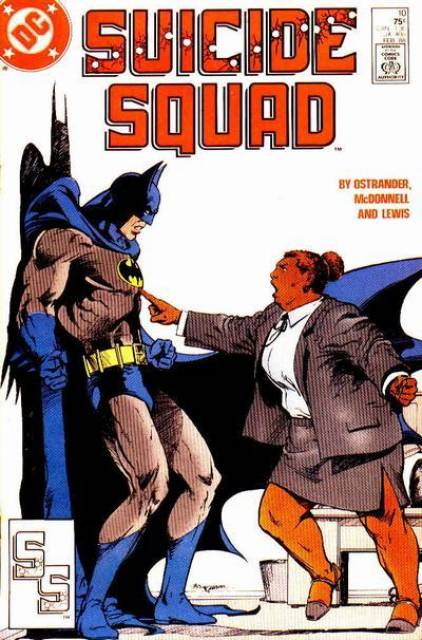
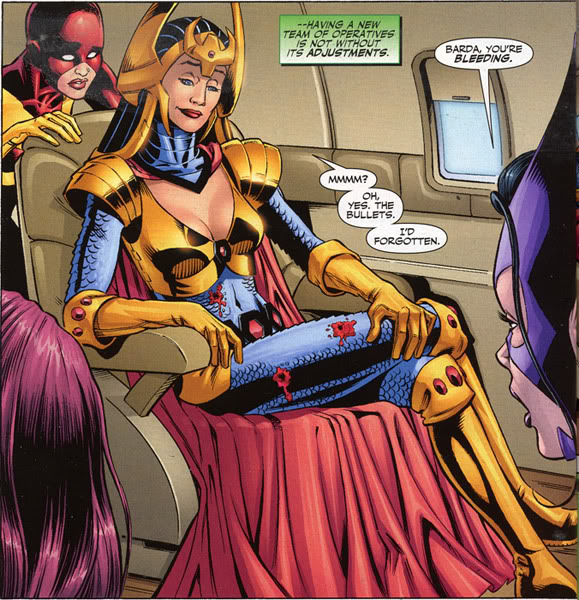
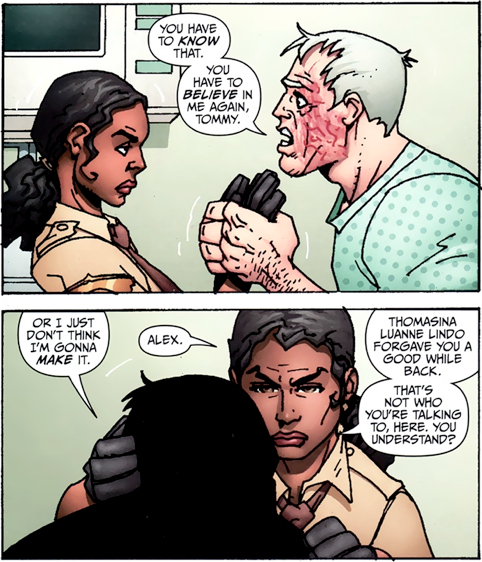



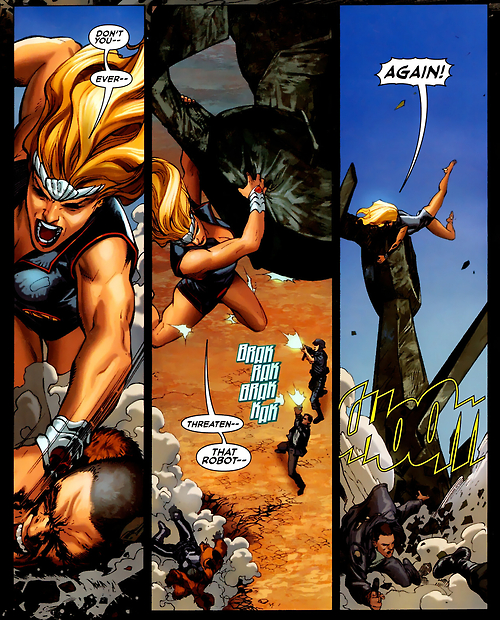


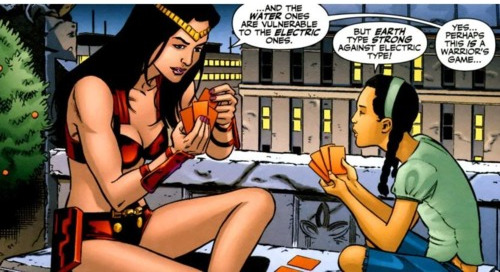




You should add “like” buttons so I don’t have to make my lazy ass type out “I like this” but then, I’m lazy.
I have no end of irritation with people who think “strong female character” simply translates into ass kicking. “Complex” is another good word. Another is “what would you have her do if she were male?” which of course usually garners blank looks because she wouldn’t be in the situation she is if she were which just goes to show… *sigh*
Yes, Red Hulk smash gender binaries!
LikeLike
Cap’n Laity– alex and I will look into “like” button options for the lazy among us. (And, thanks)
LikeLike
Yay hurray! LOVE this.
The particular flavour of noir-esque ass-kicker that surfaces whenever anyone says ‘strong female character’ is so limited. There isn’t one type of strong. There isn’t one type of female. Thank you for so very many options.
LikeLike
Yay! Thanks, Chris!
I only wish I had remembered to include Cursed Pirate Girl:
http://www.archaia.com/archaia-titles/cursed-pirate-girl/
LikeLike
Great piece. Couldn’t agree more that we need is more “strong” as in “strongly characterized” characters of every type, and more variety.
LikeLike
Thanks, Professor!
LikeLike